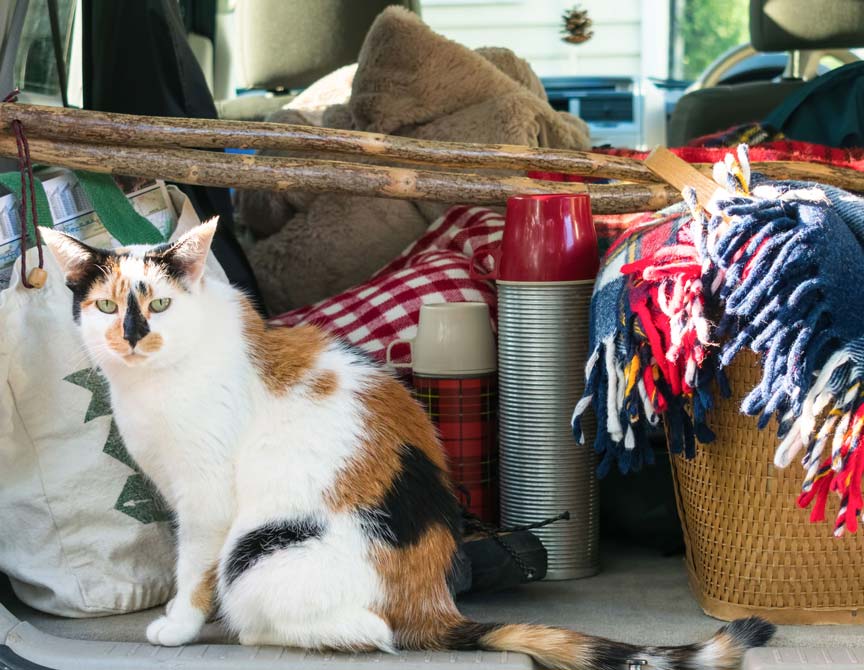Tips for Traveling in an RV With a Cat

RV traveling is popular in the United States and only getting more so. Whether you're a weekend warrior or a full-time RV-liver, you may want to have your cat with you. Look at these ways to help make it safer to RV with your cat.
Use a Restraint System While Moving
While the RV is moving, your cat will be safest if he is restrained. For cats, that usually means putting them in a carrier or crate that is secured, so it can't slide around. The crate should be attached to something in the RV that doesn't move. Some people use seat belts, and others use straps and bolts for a more permanent solution.
If your RV is a trailer that you haul with another vehicle, your kitty should be in the tow vehicle with you during travel, not in the trailer alone.
Be Diligent During Set-Up and Tear-Down
The most vulnerable times for your cat when traveling by RV are set-up and take-down at campsites. That's because a lot is going on, and your kitty may escape or be injured.
If possible, keep your cat in the crate he travels in until the RV is completely set up. Then, let him out or move him from the tow vehicle to the trailer and then let him out, ensuring all the doors are closed first. Of course, if you're leaving him in the tow vehicle while you set up, you must make sure it doesn't get too hot in there.
If your RV has slide-outs, never put them in or out without first locating and securing your cat. Cats like to hide in small spaces, and he may get crushed.
When you are tearing down camp, locate your cat and confine him before you begin. Otherwise, he may get injured or escape during the commotion of breaking down camp and getting the RV ready to move.
Consider the Temperature While Camping
Once your RV is set up, you will probably sometimes wish to leave your cat inside it while you do something outside. Remember that the vehicle can get too hot inside, just like a car. Leave the air conditioner on to keep the RV a safe temperature.
To be extra safe, consider getting a remote temperature sensor to keep tabs on the heat level inside the RV. The reason to do that is in case of a power failure or an air conditioner malfunction. The device can monitor the temperature and send an alert to your phone if it gets too high.
Always Keep Up-To-Date ID on Your Cat
It's crucial that your pet always has multiple forms of ID on, in case he darts out the RV door and escapes. It won't be as easy for him to find his way back as it may be if you were at a permanent home.
If you plan to travel in an RV with your cat, have him microchipped, and make sure you register the chip with the company and keep your contact information up to date with them.
Additionally, keep a breakaway collar with a visible ID tag, also with current contact information, on your cat at all times while traveling.
Between those two types of identification, it will be more likely that your cat will be returned to you if he does escape while you're traveling.
Check with Your Vet
Before leaving on a trip, make an appointment to have your cat checked out. Make sure he's up to date on all vaccines. If you're going to a different state or country, find out the requirements your destination has for cats coming into their area and make sure you have everything you need. A health certificate may be required, as well as vaccines or blood tests your cat may not otherwise have.
Additionally, find out what types of parasite control are recommended for the area you're visiting and get your kitty on them ahead of time. You may wish to contact a vet at your destination for specific recommendations.
It can also be helpful to have your regular veterinarian print out a complete medical and vaccine history for you to take with you. That way, if you need to see a vet for an emergency while you're traveling, you'll be able to give them the records. That will help the doctor be as well-informed as possible.
Make Sure You're Well-Supplied
Think about how long you'll be traveling, and make sure you have enough cat supplies for the trip, including food and medication. It's not always easy to find what you need while you're on the road in unfamiliar places, so it's better to be over-supplied than to run out of things.
You May Also Like These Articles:
How to Train Your Cat to Walk on a Leash
How to Take Your Cat on a Plane





